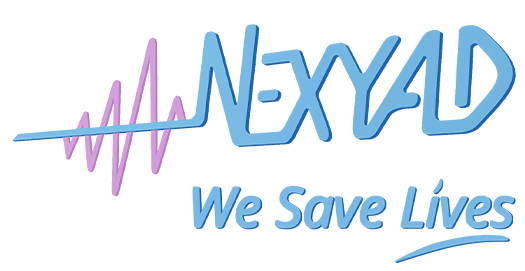REAL TIME ONBOARD RISK ESTIMATION CORRELATED WITH ROAD ACCIDENT :
AN ENTIRELY SOLVED PROBLEM AND A PRODUCT ALREADY AVAILABLE FOR DEPLOYMENT
by NEXYAD
(Version Française ici)
INTRODUCTION
Measuring road safety in the context experienced by the driver is a topic of interest for several activities :
. car manufacturers, who can inform the driver of potential dangers
. autonomous vehicle developers who need to prove that the driving actually minimizes risk of accident.
. fleet managers and insurance companies who wish to measure the risk taken by drivers (how they drive)
. managers of road infrastructure that alway change infrastructure to adapt and lower the risk of accident
The company NEXYAD has been developing since 2001 an embedded onboard module, SafetyNex, to
estimate in real time the risk of accident.
PRECONCEIVED IDEAS ABOUT ROAD ACCIDENTS AND DRIVING STYLE
Many trials have been completed or in progress, particularly by insurance companies and fleet managers,
In order to measure what is called the « driving style ».
The assumption is that some drivers are more « nervous » than others, and that this has an impact on the accident: those that speed up or slow down quite often brutally would be « bad drivers » while those with a quieter driving style would be « good » drivers.
This assumption is contradicted by the facts. There is no statistical connection between the driving style and
the accident.
Formally, one can easily fancy very well that if a driver operates very quietly, without slowing, without
accelerating at 30 km / h, and if this driver passes through a stop road sign without braking … then the driving style is quiet but very accident-prone.
We then see that beyond the possible statistical link (that doesn’t exist), there can be no relationship of cause and effect.
All experiments that were conducted led to this result.
All those that will be conducted, based on more or less intelligent thresholding of the acceleration values are doomed to failure.
Do not confuse eco-driving and safe driving.
Driving style cannot be interpreted itself without context description :
. infrastructure shape and characteristic, on which the vehicle is traveling
. traffic (presence of other road users)
. weather conditions (visibility, grip, …)
. level of driver vigilance (distraction, drowsiness, sleep …)
NEXYAD has developed a scalable solution capable of taking into account all these factors.
SafetyNex is therefore able to estimate the risk of driving using all those variables.
Version 2.1 of SafetyNex, under deployment, takes into account the adequacy of driving style with the type and shape of infrastructure (breaks on route characteristics, turns, pedestrian crossings, intersections …).
This version has been intentionally reduced to « driving style vs infratructure characteristics », because it already gives a 90% correlation with accident and because this version is deployable at very low cost:
. on smart phone
. electronic device (developed by an automotive tier one company), without using the OBD socket)
CORRELATION OF RISK OF ACCIDENT ESTIMATED BY SafetyNex V2.1 AND ACCIDENT
NEXYAD participated in collaborative research programs since 2001, and worked then with experts from the road equipment.
In particular, SARI research program led to detecting what experts call « Break on the route characteristics ». For example, a turn with a big curve may be a danger when it arrives behind a long straight line, while the same curve will not be dangerous bend on a mountain road.
NEXYAD published a paper at the conference on road safety May 6, 2010 in Paris: PRAC 2010
Risk Prevention and Save The Conduct, Session 1 Characterization of road risk vs. infrastructure
« Evaluation du risque routier pour l’aide à la conduite ou le diagnostic de l’infrastructure », Johann Brunet, Pierre Da Silva Dias, Gérard Yahiaoui, PRAC 2010, Mai 2010, Paris.
The work that led to this publication were integrated in the available product SafetyNex. This means that by construction, the risk estimated by SafetyNex is correlated to the accident. This is true by construction, and NEXYAD conducted tests on roads, downtown, on motorways in urban areas, etc … and was able to validate this result.
PRINCIPLE OF SafetyNex V2.1
SafetyNet is a knowledge based system (expert system) which applies rules of the experts of the equipment.
These rules are stored in a rules data base in a mathematical form that can adapt to gradual actual characteristics of the infrastructure.
Required inputs are :
. the navigation map and the GPS: To examine the shape and type of the infrastructure located downstream of the vehicle (turns with their radius of curvature, points of interest like pedestrian crossing, crossroads, etc …)
. the instantaneous vehicle speed
From these two inputs, SafetyNex evaluates, by applying the rules, the adequacy of the driving speed of the vehicle to difficulty and danger of infrastructure.
A sporty driver accelerating hard, braking hard, but passing dangerous places at low speed will be scored with a low risk.
A quiet driver that passes through a stop road sing at 30 km / h without braking will be scored with a high risk.
A brutal braking cannot be considered as « bad driving » if it is necessary to avoid an accident …
We see then, that SafetyNex risk estimation is not correlated with the absolute value of acceleration, but with ACTUAL speed adaptation to difficulty and danger of the infrastructure, in real time.
Additional inputs (optional) are already scheduled, and can afford to modulate the estimated risk to increase acuracy of SafetyNex :
. grip (if one has a sensor to connect to the input provided for the purpose of SafetyNex)
. weather report (if one has the temporal and spatial information)
. atmospheric visibility (if one has adequate measure: example: a camera and the measuring module of atmospheric visibility : VisiNex)
. distance to potential obstacles (if it has an adequate sensor : eg radar, lidar, or camera with RoadNex ObstaNex modules)
. a driver distraction factor (if the driver is observed with a camera and / or if one monitors the activity of mobile phone, etc …)
All these additional inputs are already ready to be used by SafetyNex but of course, they increase the cost of deployment, involving sensors (camera, …) and additional computing power before getting in SafetyNex to process signals and images from the optional sensors.
Using SafetyNex V2.1 with only the required inputs already allows a very high correlation of the estimated risk with the accident. We recommend to implement this version, already infinitely more effective than any other onboard measurements.
The interest of SafetyNex is that the future is already assured: Moore’s Law by rapidly lowering the cost of electronics and embedded computing, SafetyNex is ready to process the additional inputs, when users want to integrate cameras and sensors.
TYPICAL USES OF SafetyNet V2.1
. Insurance Companies:
– Pay how you drive
– Predictive modeling of bonus malus: the same accident under the same conditions does not lead to the same conclusions based on accumulated historical and recording the last seconds risk SafetyNex
– Generation of a dumb risk variable, correlated to the accident, to help actuaries refine pricing (big data)
. Fleet managers
. Automotive equipment suppliers:
– Alarm on risk
– Intelligent Navigation able to advise the driver
. Engineers and researchers from autonomous vehicle:
– Driving Quality Assessment generated by the robot
CONCLUSION
Embedded estimation of road risk of accident is now a problem completely solved by a product available for deployment, SafetyNex.
SafetyNex is deployable at Low cost on:
. mobile phones
. electronic device of a Automotive Tier 1 supplier (without plugging the OBD).
And SafetyNex already planned to integrate (once the cost is acceptable) grip sensors and cameras (for example) to estimate traffic and atmospheric visibility, as well as information such as weather and driver distraction.
All of these are already processed by SafetyNex rules based system, so that the tool can quickly evoluate with each decrease in the cost of sensor elements and cost of computing power needed to compute sensors outputs.
To deploy SafetyNex, contact NEXYAD: Olivier BENEL obenel@nexyad.net +33 1 39 04 13 60















